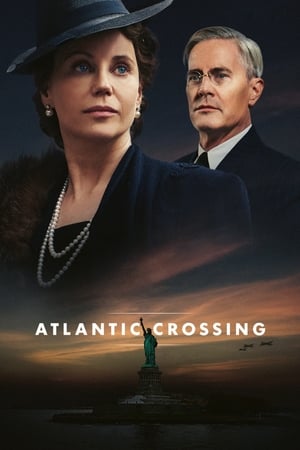"Exciting Politics and Passion"
What You Need To Know:
The first two episodes of ATLANTIC CROSSING are extremely well-directed, with beautiful sets and cinematography and wonderful acting. The historical authenticity of the first two episodes is excellent. Every moment of the first two episodes in ATLANTIC CROSSING has a tremendous jeopardy. They also have a strong moral worldview and extensive Christian content, with very few negative elements. The jeopardy in ATLANTIC CROSSING is alleviated by very strong Christian appeals to God by the children and the parents. MOVIEGUIDE® advises caution for younger children because of the war scenes and some intense political issues.
Content:
More Detail:
ATLANTIC CROSSING is one of the most exciting historical television miniseries focusing on the Norwegian royal family trying to save Norway from the Nazi Germany at the beginning of World War II by reaching out to President Roosevelt and King George VI of England. The first two episodes of ATLANTIC CROSSING are extremely well-directed, with beautiful sets and cinematography and wonderful acting, with very few negative elements.
The first episode opens with the Crown Prince, Olav and Crown Princess, Martha, traveling by train on their visit to the Untied States, to elicit help on the verge of World War II in face of the threat of Hitler’s growing power. They clearly love each other and start to get romantic while fully clothed while the train pulls into the station, where a band playing the Norwegian anthem and local American officials are waiting to greet them.
They meet with President Franklin Delano Roosevelt, who understands their concern about Adolf Hitler’s intentions, but Roosevelt is told by his Secretary of State, Cordell Hull, that the American people want peace and do not want to be involved in another European war. Germany needs Norway because Germany needs Norway’s iron ore necessary to making steel for their armaments. By the way, Churchill knew this and tried to get England to take a more active role in protecting Norway, but he was overruled, and England only gave lackluster support with few troops badly equipped.
When Olav and Martha return to Norway to meet with Olav’s father, King Haakon, rumors of Hitler’s intentions have increased dramatically. Martha pressures U.S. Ambassador Florence Jaffray “Daisy” Harriman for information, and the Ambassador tries to be discreet, but indicates Germany needs the iron ore. Norway has declared itself neutral, just as Sweden and Denmark did, thinking that would protect them form invasion. The King and the Crown Prince are more concerned than the cabinet and want to mobilize the army, but the Prime Minister says the government doesn’t want to do anything which would upset the Germans.
Then, the Germans attack and quickly take over Denmark. Next, they start destroying Norwegian ships, even passenger ships with mothers and children, and they quickly move into Norway. Prince Olav sends Martha and the children to Sweden since she’s the niece of the Swedish king. They’re stopped by Norwegian militia, who tell them the Germans are everywhere. By the way, the Germans have already occupied the royal palace in Oslo and threatened the staff with torture to tell them where the royal party went and then shoot the royal pet dog.
The royal family flees north, but the German planes control the airspace and eventually force them to abandon their cars and seek shelter in the woods as the German planes bomb and strafe the royal and government leaders.
When Martha gets to the border with her children, the Swedish guards refuse to let her in because they don’t have their passports. They crash the border and eventually make it to Stockholm and the Swedish royal palace. Her mother and father welcome her warmly, but the King of Sweden leans toward Germany, especially when the German ambassador tells him Sweden will be in jeopardy if they shelter the Princess.
Throughout this flight, plans are made to reunite the Princess with the Crown Prince, none of which work out.
Finally, after much debate, the King of Norway and the Crown Prince are taken out of Norway by a British ship. They get to England and stay at Buckingham Palace, where their cousin, King George VI, also known as “Bertie,” tries to figure out ways to help them.
However, Princess Martha can’t get back to Norway or England because the Germans control the airspace. So, the Crown Prince convinces President Roosevelt to send an American ship with a huge flag painted on the side to extract Martha and her children from Finland.
Having been produced by Norwegian television, the first two episodes are extremely accurate and pro Norwegian. The Norwegians did look toward England and the Allies for help while the Swedes, who had numerous ties to Germany, leaned toward Germany but remained neutral.
The episodes clearly show the horrors of being in the way of Hitler’s military might. Having been on the board of the Theodore Roosevelt Association, I commend the series for showing President Roosevelt as more concerned about Hitler and the freedom of Norway than much of the news in the United States at that time, which favored neutrality because of the tremendous cost of World War I. FDR’s wife, Eleanor, on the other hand, was further to the left of FDR and therefore was not as warm and welcoming to the Norwegian royals. Furthermore, the American Secretary of State, Cordell Hull, is greatly opposed to the United State getting involved in any way in a European war.
Having been to Norway several times and spoken at the Parliament, the historical authenticity of the first two episodes is incredible. Once conquered by Germany, Norway fielded one of the greatest guerrilla wars against Hitler in Europe. Hindsight is always better than foresight, but if England had listened to Churchill or if FDR had asserted and convinced the American people of the dangers of Hitler, World War II would have ended much sooner.
Every moment of the first two episodes in ATLANTIC CROSSING has a tremendous amount of jeopardy. This jeopardy is alleviated by very strong Christian prayers by the children and also by the parents. These prayers are not tossed off; they are in-depth appeals to God for help.
MOVIEGUIDE® advises caution for younger children because of the war scenes. Also, some of the political issues may be too intense for younger children, However, older children would benefit by seeing the first two episodes of this miniseries, which is reminiscent of the great series from the Golden Age of Television.
The third episode focuses more on FDR and the Crown Princess, and is not as worthwhile.



 - Content:
- Content: 



